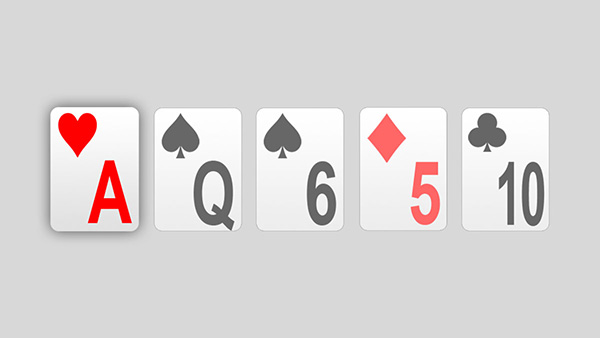Odds for the Later Streets with a High Hand
We’ll assume that we don’t flop any direct draw but that we do hold two good overcards that might improve to the best hand if they pick up a pair.
Overcards provide us with 6 live outs to make top pair.
Probability of hitting on the turn or river -
Odds of hitting on the turn = 6/47 = 0.1277 or roughly 12.8%
Odds of hitting on the river = 6/46 = 0.1304 or roughly 13%
Of course, it’s worth keeping in mind that unless our overcards are specifically AK, then it’s possible for an overcard to fall on the turn, making it impossible for us to make top pair by the river.
Probability of hitting by the river -
To figure out our odds of hitting by the river, we’ll calculate our odds of not hitting and then subtract them from 100.
Odds of not hitting on the turn = 41/47
Odds of not hitting on the river = 40/46
Odds of not hitting on the turn or river = 41/47 * 40/46 = 0.7586 or roughly 75.9%
The odds of hitting by the river is hence (100 – 75.9) roughly 24.1%
In truth, however, 24.1% chance of catching a pair might provide an overly optimistic portrayal of how things really are for a few reasons -
- We might hit, but then an overcard hits by the river
- We might hit, but a flush completes by the river
- We might hit, but a straight completes by the river
So chasing top-pair type holdings is not usually a great idea due to the potential for them being dominated even after hitting.
Implied Odds Analysis of a Pair
The implied odds of one pair type hands cannot be relied on in Hold’em. As a general rule, one-pair type hands are typically medium strength at best. While a top pair is frequently the best hand, it can’t play for large amounts of chips. By the time our opponent wants to invest most of his stack, he’ll have our top pair dominated.
For this reason, one-pair hands are susceptible to suffering from reverse implied odds rather than benefiting from implied odds.
Basic Strategy Advice
One-pair type holdings are rarely worth playing for stacks (assuming 100bb). By the time our opponent wants to get 100bb stacks in, he’ll typically have our pair dominated.
Due to the lack of implied odds when hitting, it is, therefore, not typically a good idea to try and “chase” a top pair type holding. It’s common for recreational players to play Ax type hands preflop and hang on hopelessly postflop trying to catch that Ace after missing the flop.
This might be reasonable if a pair of Aces was guaranteed to win the pot, but often one-pair type hands still go on to lose when facing additional action.
The exception is high-ranked TPTK (top-pair-top-kicker) type holdings, which can sometimes warrant getting 100bb stacks in, especially if a lot of the chips have already gone in preflop (i.e. it’s a 3bet or 4bet pot).
Method (High Hand) | Probability (%) |
| | |
Flopping a High-card Hand with any starting hand | 63 |
Flopping a High-card Hand with any unpaired starting hand | 66.9 |
Flopping a High-card hand with a pocket pair | 0 |
Flopping a High-card hand with Ako | 67.2 |
Flopping a High-card hand with T9s | 65.4 |
Flopping overcards with unpaired starting hand | 7.64 |
Flopping overcards with AKo | 67.2 |
Flopping overcards with T9s | 16.2 |
Flopping a Gutshot with an unpaired starting hand | 10.3 |
Flopping a Gutshot with AKo | 11.3 |
Flopping a Gutshot with T9s | 16.6 |
Flopping an OESD with an unpaired starting hand | 3.47 |
Flopping an OESD with AKo | 0% |
Flopping an OESD with T9s | 9.6 |
Odds of making a pair on the turn after flopping air | 12.8 |
Odds of making a pair from turn to river with air | 13 |
Odds of making a pair from flop to river with air | 24.1 |

